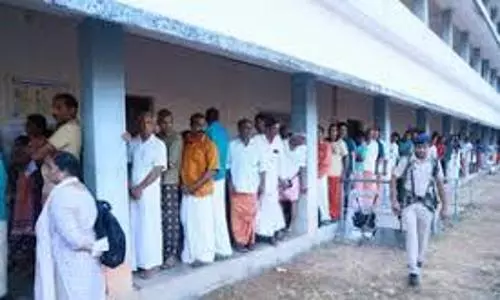
Servers that block ration
text_fieldsAn 11-year old child Santoshi Kumari died of starvation in Jharkhand in September last year and it was not due to any shortage of food in the village.
The food grains that should be made available with subsidy according to the Central Government's Antyodaya Anna Yojana (AAY), had already reached the public distribution centres in the area. But in order to be eligible for that, the ration card must be linked to Aadhaar; and the consumers must also be recognised with the help of a biometric machine placed in the ration shops. The distribution of ration will be possible only after that. Santoshi's family had not received an Aadhaar card at the time prescribed by the government. The family was hence denied ration for weeks. Initially their neighbours helped them. But later the neighbours gave up pushing Santoshi's family into starvation. The child succumbed to death soon after that. After a few days, Baidyanath, a 40-year old rickshaw puller also died of hunger. He had an Aadhaar and a ration card as well. But he was denied ration after the biometric machine at the shop failed to read his fingerprints. All these are not any isolated incidents. This 'machine ghost' has blocked the ration of many in Jharkhand and UP; some have lost their lives. It is the biometric system which was employed as part of the National Food Security Act, 2013 implemented by the Central Government with much pomp to ensure subsidised ration to two out of three persons in the country, that has driven the people to such an extent of starvation. The flaws and irregularities of late, on the part of public distribution centres functioning in Kerala that is relatively far ahead of other states, are a continuation of the above incidents. The distribution of ration in the state has floundered for weeks not due to the shortage of food grains, but due to the defective working of the EPOS (electronic point of sale) machines and server that controls them, which have been imported by the central and state governments with much vaunt.
And now, the ration dealers have been forced to shut down their shops for two consecutive days. After EPOS machines have been set up in the state, stalling of ration distribution has ceased to be news at all. The distribution of food grains was held up for 20 consecutive days last April. EPOS machines were installed for curbing corruption and hoarding that takes place in ration shops and also for making the public distribution system more transparent. There is a big concept behind this. Firstly, the ration card must be linked to Aadhaar in order to receive food grains from ration shops. The card owner will receive his share of ration only if his biometric details are read accurately by the EPOS machine installed in the shop by giving his fingerprint. The benefit of this machine is usually said to help in clearly understanding the stocks, distribution and balance stocks in the shops thereby enabling thetracking of those who receive ration without eligibility. At first glance, this can be deemed to make the public distribution system transparent. However, it was when this scheme was implemented as an experiment in Jharkhand in August 2016 that the tales of starvation deaths came to light. Also, the public distribution system in the area totally collapsed. Black market and hoarding also increased.
If lack of adequate infrastructure facilities including electricity and internet connection was the reason for the failure of this scheme in states including Jharkhand, it is a different scenario in Kerala. Here, there are hardly any areas which lack such facilities. Still, if the distribution of ration has stalled in the state, it is our bureaucrats who are responsible for that. It will have to be said that the inefficiency of the officials and traders alone is what brought matters to this extent. The present problems are not caused only by EPOS machines that links ration shops, FCI warehouses and district supply offices, and the server that controls all of these. Because of the frequent breakdowns of the existing server, a new one was procured at a cost of Rs 5.5 crore, but that could not be commissioned so far. Not only that, ration pilferage which was expected to be ended through the EPOS system, is continuing unabated. The media had reported several times that the entitlement of consumers who do not take delivery of their ration, was widely siphoned off. After each such report the authorities would assure that strict scrutiny would be made, but all such enquiries would kneel before the ration mafia and end up as farce.
It is when in Supplyco, online food distribution is running smoothly that such pilferage is happening in ration shops. In other words, what is seen here is a perfect example of looting in daylight under the cover of technology. Seven and a half decades ago, when the state had a food crisis, there were agitations demanding that food grains be seized from landlords and distributed at fair price, and it was such agitations that eventually led to public distribution system. And as a continuation of that, Kerala implemented statutory ration about half a century ago. As in the sectors of health and education, this model was another gift of Kerala to the world. The servers in question, which block ration now are upsetting that tradition. It needs to be accepted only if technology smoothens the present machinery. Otherwise it is to be thrown out.























